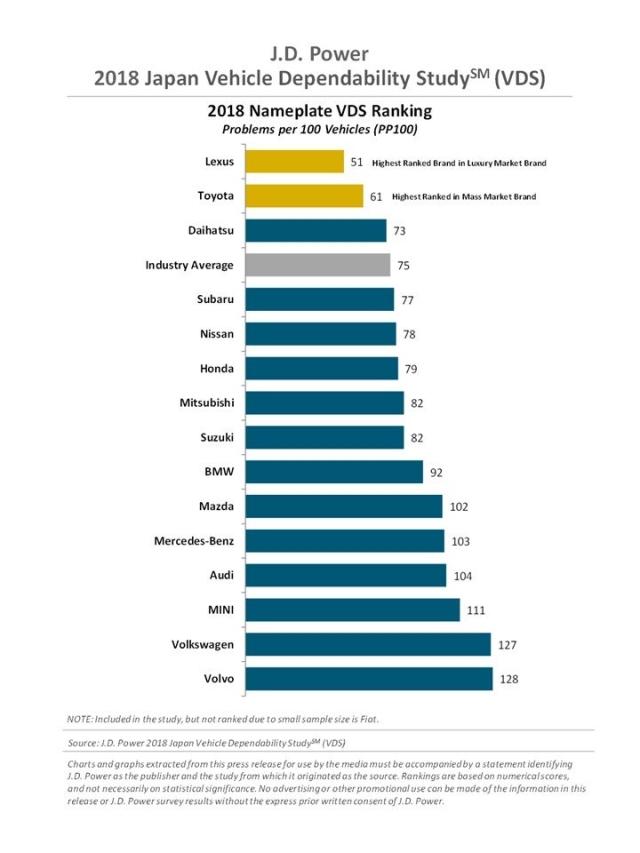Vehicle Dependability in Japan Remains Stagnant, Manufacturers Must Improve Durability, J.D. Power Finds
Lexus Ranks Highest among All Brands
TOKYO: 25 Oct. 2018 — Overall, the number of reported problems is almost the same as in 2017, according to the J.D. Power 2018 Japan Vehicle Dependability StudySM (VDS), released today.
The VDS is conducted globally and serves as the industry benchmark for vehicle dependability. The Japan study, now in its fourth year, measures problems experienced during the past 12 months by original owners of vehicles after 37 to 54 months of ownership. The study examines 177 problem symptoms across eight categories: vehicle exterior; driving experience; features/ controls/ displays (FCD); audio/ communication/ entertainment/ navigation (ACEN); seats; heating, ventilation and air conditioning (HVAC); vehicle interior; and engine/ transmission. Overall dependability is determined by the number of problems reported per 100 vehicles (PP100), with a lower score reflecting higher quality. The overall industry average increases by 1 PP100 to 75 PP100 and remains at the same level as in 2017.
“Higher repurchase intent is seen for Lexus and Toyota, which rank highest and second highest among all brands, where 88% and 85%, respectively, say that they ‘definitely would’ or ‘probably would’ repurchase the same brand,” said Atsushi Kawahashi, Senior Director of the Automotive Division at J.D. Power, Tokyo. “This indicates that there is a correlation between experience of problems and repurchase intent. Auto manufacturers need to work on further improvement in durability to increase owners’ brand loyalty, as customers are keeping their vehicles for longer periods of time.”
Following are some of the key findings of the study:
-
Exterior, interior, engine/ transmission and ACEN remain the most problematic: The vehicle exterior (14.5 PP100), vehicle interior (14.2 PP100), engine/ transmission (11.8 PP100) and ACEN (11.6 PP100) categories remain the most problematic areas, as in 2017, and account for 70% of the reported problems.
-
Three of the five most frequently reported problem symptoms are ACEN-related: The most frequently reported problem symptom is air vents smell unpleasant (3.3 PP100), followed by navigation system—difficult to operate (2.1 PP100); brakes are noisy (2.0 PP100); built-in Bluetooth mobile phone/ device has frequent pairing/ connectivity issues (1.9 PP100); and navigation system—inaccurate (1.9 PP100). Three of the five problem symptoms are in the ACEN category. Navigation systems and Bluetooth are not basic features of a vehicle. However, more new vehicles are equipped with these features and they are essential for making a vehicle comfortable and convenient. For this reason, these results cannot be overlooked.
-
Dependability improves in the minivan segment, while deteriorating in the midsize segment: The minivan segment shows the greatest decrease in problems (-6 PP100 year over year). Dependability improves in the engine/ transmission, FCD and ACEN categories from 2017. In contrast, the largest increase in problems is in the midsize segment (+14 PP100 year over year), as dependability deteriorates in the ACEN, vehicle interior, vehicle exterior and FCD categories.
-
There is a correlation between mileage and the number of reported problems: The study finds that the number of reported problems rises as mileage increases. Dependability averages 59 PP100 for vehicles that travel less than 10,000 kilometers, while dependability is 133 PP100 for vehicles that travel 70,000 kilometers or more, a 74 PP100 gap. Between vehicles that travel less than10,000 kilometers and those that travel 70,000 kilometers or more, the largest gap is in the vehicle interior category (a gap of 21.1 PP100), followed by the vehicle exterior category (a gap of 15.9 PP100). By segment, the largest gap is in the compact segment (3.1 times the number of reported problems), followed by the mini-car segment (2.4 times).
-
Shift lever knob and exterior light problems have increased: In the vehicle interior category, the largest increase in problems is in shift lever knob—excessively worn/ faded, followed by materials scuff/ soil easily; door panels—excessively worn/ faded; carpet—excessively worn/ faded; and instrument panel/ dashboard—squeak/ rattle/ other noise. In the vehicle exterior category, the largest increase in problems is in exterior light—bulb failed, followed by excessive road noise; exterior light—condensation/ discoloration/ clouding; paint imperfection; and exterior rust/ corrosion.
Study Rankings
Lexus ranks highest among brands, with a score of 51 PP100. Lexus is followed by Toyota (61 PP100) in second place and Daihatsu (73 PP100) in third place. Lexus also ranks highest in the luxury segment and Toyota ranks highest in the mass market segment.
Highest-Ranked Models
Honda N-ONE ranks highest in the mini-car segment with a score of 55 PP100, followed by Daihatsu Move (62 PP100) in second place and Nissan Moco (63 PP100) in third place.
Toyota Vitz ranks highest in the compact segment with a score of 52 PP100, followed by Toyota Ractis (54 PP100) in second place and Toyota AQUA (56 PP100) in third place.
Toyota SAI ranks highest in the midsize segment with a score of 38 PP100, followed by Toyota Corolla (50 PP100) in second place and Nissan Leaf (66 PP100) in third place.
Toyota Esquire ranks highest in the minivan segment with a score of 45 PP100, followed by Toyota WISH (61 PP100) in second place and Toyota Noah (64 PP100) in third place.
* The overall industry average for vehicle dependability is 75 PP100.
* Models in the large segment are not included in the rankings due to insufficient market shares.
The 2018 Japan Vehicle Dependability Study is based on responses from 20,835 purchasers of new vehicles in the first 37 to 54 months of ownership and includes 16 automotive brands and 116 models. The study was conducted via Internet from June through July 2018.

